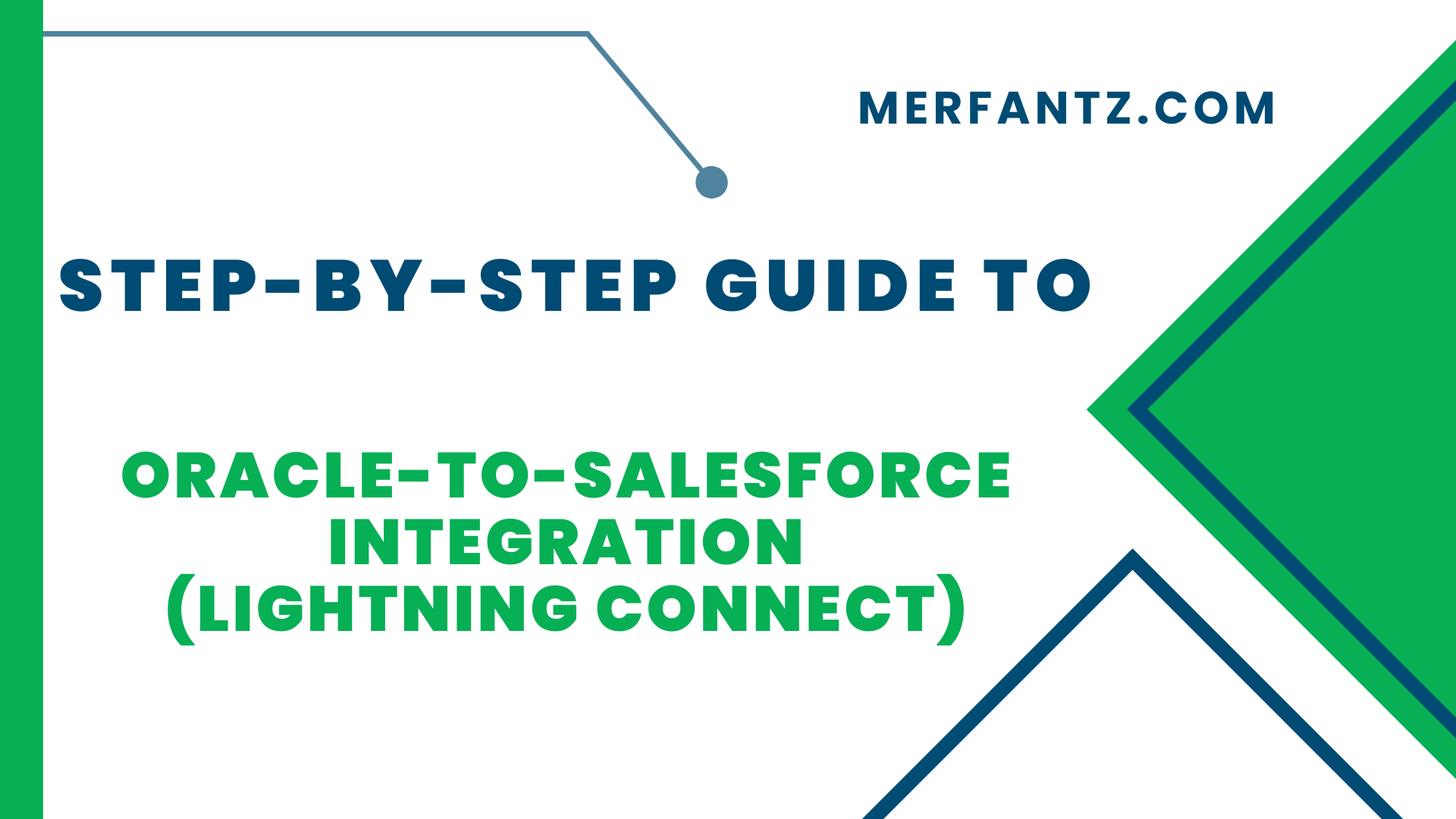Introduction to Oracle-to-Salesforce Integration
Oracle-to-Salesforce Integration is a powerful solution that allows businesses to seamlessly connect their Oracle database with the Salesforce CRM platform. By integrating these two systems using Lightning Connect, organizations can achieve real-time data synchronization, enabling them to make informed decisions, enhance customer relationships, and streamline their business processes. In this comprehensive guide, we will walk you through the step-by-step process of setting up and implementing Oracle-to-Salesforce Integration using Lightning Connect.
Whether you are an IT professional, a business analyst, or a Salesforce administrator, this guide will provide you with all the essential information and instructions to successfully integrate Oracle and Salesforce. You will gain a deep understanding of Lightning Connect and its benefits, learn about the prerequisites for integration, and discover best practices to ensure a smooth and efficient integration process. Get ready to unlock the full potential of your data and maximize the value of your Oracle and Salesforce investments.
Understanding Lightning Connect and its Benefits
Lightning Connect is a native Salesforce integration tool that enables seamless integration with external data sources, such as Oracle databases. It provides a real-time and unified view of data from multiple systems within the Salesforce environment, eliminating the need for data replication or manual data imports. By leveraging Lightning Connect for Oracle-to-Salesforce Integration, organizations can harness the power of real-time data synchronization, ensuring that the data in Salesforce is always up-to-date and accurate.
The benefits of using Lightning Connect for Oracle-to-Salesforce Integration are numerous. First and foremost, it eliminates the need for complex and time-consuming data integration projects, as it establishes a direct connection between Oracle and Salesforce. This enables organizations to leverage the full capabilities of Salesforce without duplicating data or managing data inconsistencies. Furthermore, Lightning Connect offers a secure and scalable integration solution, allowing businesses to seamlessly access and update Oracle data within the familiar Salesforce interface.
Prerequisites for Oracle-to-Salesforce Integration
Before diving into the Oracle-to-Salesforce Integration process, it is essential to ensure that you have met the necessary prerequisites. Firstly, you should have a functioning Oracle database with the required data that you want to integrate with Salesforce. Additionally, you need to have access to a Salesforce organization with appropriate administrative privileges to configure and manage the integration. It is also recommended to have a solid understanding of both Oracle and Salesforce data models to effectively map data fields during the integration.
Another important prerequisite is having Lightning Connect enabled in your Salesforce organization. Lightning Connect is a feature available in certain Salesforce editions and requires proper configuration before using it for data integration. You may need to consult with your Salesforce administrator or contact Salesforce support to enable and configure Lightning Connect if it is not already activated in your organization. Ensuring these prerequisites are met will set the foundation for a successful Oracle-to-Salesforce Integration.
Setting up the Oracle Data Source
To initiate the Oracle-to-Salesforce Integration, you need to set up the Oracle data source in your Salesforce organization. This involves establishing a connection between Salesforce and your Oracle database. Salesforce provides a straightforward process to configure the connection, requiring you to provide the necessary connection details, such as the Oracle database URL, username, password, and any required authentication parameters. Once the connection is established, Salesforce will be able to retrieve data from your Oracle database in real-time.
During the setup process, you may need to collaborate with your Oracle database administrator to ensure the necessary access permissions are granted to establish the connection successfully. It is crucial to secure the connection by following best practices, such as using secure authentication methods and limiting access to authorized users. By setting up the Oracle data source correctly, you lay the groundwork for seamless data integration between Oracle and Salesforce.
Configuring the Salesforce Lightning Connect External Data Source
Once the Oracle data source is set up, the next step is to configure the Salesforce Lightning Connect external data source. In this step, you define the connection details and specify the query capabilities to retrieve data from the Oracle database. Salesforce provides an intuitive interface to configure the external data source, allowing you to enter the necessary information, such as the data source name, description, and connection details. You can also specify the query capabilities, such as the fields to retrieve and any filters or sorting criteria.
During the configuration process, it is essential to ensure that the connection details match those of the Oracle data source. This includes verifying the database URL, username, password, and any additional authentication parameters. Once the external data source is configured, Salesforce will establish a connection with the Oracle database and make it available within the Salesforce environment. This enables you to access and interact with the Oracle data seamlessly, as if it were native Salesforce data.
Mapping Data Fields between Oracle and Salesforce
Mapping data fields between Oracle and Salesforce is a critical aspect of the integration process. It involves identifying corresponding fields in both systems and establishing the relationships between them. Salesforce provides a powerful mapping feature that allows you to define the mapping rules and transformations to ensure data consistency and accuracy during the integration. You can map fields one-to-one or perform more complex transformations using formulas, lookups, or custom logic.
To successfully map data fields, it is crucial to have a deep understanding of the data structures and schemas of both Oracle and Salesforce. This will help you identify the appropriate fields and ensure data integrity throughout the integration. It is recommended to collaborate with subject matter experts from both Oracle and Salesforce teams to ensure the mapping rules align with the business requirements and data models of each system. Careful and accurate mapping will ensure a seamless flow of data between Oracle and Salesforce.
Testing and Validating the Integration
Once the Oracle-to-Salesforce Integration is set up and the data fields are mapped, it is crucial to thoroughly test and validate the integration. Testing helps ensure that data is being synchronized correctly between Oracle and Salesforce, and that any configured filters or transformations are functioning as intended. You can perform test scenarios with sample data to validate the integration’s accuracy and identify any potential issues or discrepancies.
During the testing phase, it is important to verify that data changes in Oracle are reflected in Salesforce in real-time, and vice versa. You should also validate that any configured filters or conditions are correctly applied, and that the data is being transformed as expected. It is recommended to involve end-users and stakeholders in the testing process to gather feedback and validate that the integrated data meets their requirements. Thorough testing and validation will ensure a reliable and robust Oracle-to-Salesforce Integration.
Troubleshooting Common Integration Issues
During the Oracle-to-Salesforce Integration process, you may encounter certain challenges or issues that can impact the smooth functioning of the integration. It is important to be prepared to troubleshoot and resolve these issues effectively. Common integration issues include connectivity problems, data synchronization failures, or mapping errors. Salesforce provides comprehensive documentation and resources to assist with troubleshooting, and it is advisable to refer to these resources when faced with integration issues.
When troubleshooting integration issues, it is beneficial to isolate and identify the root cause of the problem. This may involve reviewing error logs, analyzing data flow, or consulting with technical experts from both Oracle and Salesforce teams. Clear communication and collaboration between the teams involved can help expedite the troubleshooting process and ensure a timely resolution. By addressing and resolving common integration issues, you can maintain a seamless data flow between Oracle and Salesforce.
Best Practices for Oracle-to-Salesforce Integration
To ensure a successful Oracle-to-Salesforce Integration, it is important to follow best practices that optimize the integration process. Firstly, it is recommended to carefully plan and document the integration requirements, including data mapping, transformations, and any specific business rules. Thorough planning helps streamline the implementation and ensures that the integration aligns with your organization’s needs. Additionally, regularly monitoring the integration and conducting periodic data audits can help identify and address any potential issues proactively.
Another best practice is to prioritize data security and compliance. Implement proper authentication methods, access controls, and encryption mechanisms to protect sensitive data during the integration process. Regularly review and update security measures to stay ahead of potential vulnerabilities. Furthermore, documenting the integration process, including configuration settings and any customizations made, will help with future troubleshooting and maintenance.
Next Steps and Future Enhancements
Once the Oracle-to-Salesforce Integration using Lightning Connect is successfully implemented, there are several next steps and future enhancements you can consider to further optimize and expand the integration. Firstly, you can explore automation options by utilizing Salesforce Process Builder or Workflow Rules to automate certain actions based on the integrated data. This can include updating records, triggering notifications, or initiating workflows based on specific data conditions.
Additionally, you can leverage Salesforce’s reporting and analytics capabilities to gain valuable insights from the integrated data. Create customized reports and dashboards to analyze the Oracle data alongside Salesforce data, enabling you to make data-driven decisions and identify trends or patterns that can drive business growth. Furthermore, keep an eye on updates and new features released by both Oracle and Salesforce, as they may offer enhanced integration capabilities that can further streamline and optimize your integration.
FAQ:
Can I integrate multiple Oracle databases with Salesforce using Lightning Connect?
Yes, Lightning Connect supports integration with multiple Oracle databases. Each database can be set up as a separate external data source, allowing you to integrate data from multiple Oracle databases into Salesforce.
Does Lightning Connect provide real-time data synchronization between Oracle and Salesforce?
Yes, Lightning Connect offers real-time data synchronization, ensuring that any changes made in Oracle are reflected in Salesforce instantaneously, and vice versa.
Can I modify the mapped data fields after the integration is set up?
Yes, you can modify the mapped data fields at any time. However, it is important to carefully consider the impact of the changes on data consistency and any downstream processes or reports that rely on the mapped fields.
How to connect to Oracle database in Salesforce?
To connect to an Oracle database in Salesforce, you can use Salesforce Lightning Connect. Lightning Connect allows you to establish a secure connection with your Oracle database and access its data in real-time within the Salesforce environment.
What is the integration between Oracle and Salesforce?
The integration between Oracle and Salesforce allows businesses to connect and synchronize data between their Oracle databases and Salesforce CRM platform. It enables real-time data exchange, providing a unified view of data from both systems and facilitating streamlined business processes and informed decision-making.
What is the difference between Salesforce Connect and Lightning Connect?
Salesforce Connect and Lightning Connect refer to the same integration tool. Initially introduced as Lightning Connect, it was later rebranded as Salesforce Connect. The tool enables seamless integration with external data sources, such as Oracle databases, allowing real-time access and interaction with the external data within Salesforce.
How do I set up a Salesforce connector?
To set up a Salesforce connector, you need to configure an external data source within Salesforce. This involves providing the necessary connection details, such as the endpoint URL, credentials, and authentication parameters. Once the connector is set up, you can access and interact with the connected system’s data directly within Salesforce, leveraging the power of integration for enhanced functionality and data synchronization.
Conclusion:
In conclusion, Oracle-to-Salesforce Integration using Lightning Connect offers a seamless and efficient way to connect your Oracle database with Salesforce, enabling real-time data synchronization and empowering your organization with accurate and up-to-date information. By following the step-by-step guide outlined in this blog post, you can successfully set up and configure the integration, map data fields, and validate the integration’s performance.
Remember to adhere to best practices, such as thorough testing, troubleshooting common integration issues, and prioritizing data security. Continuously monitor and optimize the integration to ensure its ongoing success. With the power of Oracle-to-Salesforce Integration, you can leverage the strengths of both systems and unlock new possibilities for data-driven decision-making, enhanced customer relationships, and streamlined business processes.
Author Bio
Co-Founder & CMO at Merfantz Technologies Pvt Ltd | Marketing Manager for FieldAx Field Service Software | Salesforce All-Star Ranger and Community Contributor | Salesforce Content Creation for Knowledge Sharing






